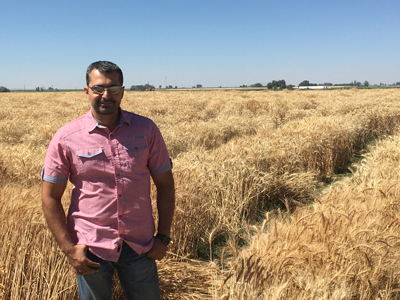Idaho Researchers Embrace Collaboration

Anyone who complains about university research being too theoretical or Ivory Tower hasn't visited the University of Idaho Aberdeen Research and Extension Center.
There, multi-disciplinary teams regularly work together on complex investigations into pests of the state's important crops like potatoes, wheat and barley.
"In these projects, we're not just looking at one or two aspects of a problem, but at whole systems," explained entomologist Arash Rashed, pictured right. "There are more collaborations, more intensity in the data. It's more realistic in practice. And by looking at the whole thing at the same time, hopefully it's more efficient."
Take their wireworm investigations, for example. When the destructive, boring pest began becoming more a problem for Idaho crops a few years ago, Rashed began working with colleagues in Aberdeen as well as at the main University of Idaho campus in Moscow to come up with answers.
One of those collaborators is barley research agronomist Christopher Rogers.
“We’re looking for indicators, environmental factors and predictors we can correlate with wireworm damage,” he explained. “We want to be able to tell growers, ‘These are the factors that make you susceptible to damage, and here’s how to manage them.’”
To do that, the team has identified nine pest species of wireworm in Idaho, and is collecting detailed soil data where each has been found. They are also working with more than 30 growers to collect historical data for 120 different fields – including how each field was planted, what was grown and how it was treated with pesticides – to do a correlation analysis and develop management guidelines.
The Institute for Bioinformatics and Evolutionary Studies at the university’s Moscow campus is also running the full gene sequence of the most common species found in Idaho, the sugar beet wireworm, because so little is known about them.
“Wireworms stay in the soil for years as larva,” Rashed explained. “Not much is known about wireworm ecology because not many entomologists study them because no one wants to retire after seeing just two or three generations of a species.”
So developing the basic science becomes a piece of the bigger effort.
“These kinds of collaborations are like gathering the troops rather than building your own tower,” Rogers said. “When we work together on these issues, we’re able to address the problems in a more complete way, and we’re often able to say, ‘Here’s why we see this pest here.’ We’re more able to address the needs of growers quickly.”
The Aberdeen researchers have similar collaborative studies looking at barley yellow dwarf virus, which is spread by an aphid. Among many other barley studies, Rogers is looking at how the virus affects nutrient cycling in infected plants and how it impacts their growth, cropping systems agronomist Xi Liang is studying how the virus affects water-use efficiency in wheat, and Rashed is looking at where the aphids come from and where they pick up the disease.
“We’re finding the natural sources of infection, including weeds, grassy weeds and corn, and looking at how aphids move through these sources and then across fields,” he said. And in windy eastern Idaho, those aphids can move a long way quickly.
“When I came back to the office from lunch today, I was carrying an ice cream,” Rashed said, “and there were two aphids blown into it by the time I got inside.”
Researchers there are also studying different varieties for their susceptibility to the disease, while plant breeders work to develop new and resistant varieties. The University of Idaho Aberdeen research station is one of the largest potato, wheat and barley breeding facilities in the country, and has its own on-site wheat laboratory and bakery where varieties are tested in real-world conditions.
“They mill the flour here and bake it into bread and cookies,” Rashed said. “It’s very effective, very efficient. And sometimes we get to try out the cookies.”